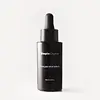What's inside
What's inside
 Key Ingredients
Key Ingredients

 Benefits
Benefits

 Concerns
Concerns

 Ingredients Side-by-side
Ingredients Side-by-side

Water
Skin ConditioningGlycerin
HumectantRosa Centifolia Flower Water
Skin ConditioningPanthenol
Skin ConditioningArgania Spinosa Kernel Oil
EmollientCalendula Officinalis Flower Extract
MaskingGlyceryl Caprylate
EmollientSimmondsia Chinensis Seed Oil
EmollientVitis Vinifera Seed Oil
EmollientXanthan Gum
EmulsifyingAlcohol
AntimicrobialDiheptyl Succinate
EmollientAloe Barbadensis Leaf Powder
Skin ConditioningTocopherol
AntioxidantCapryloyl Glycerin/Sebacic Acid Copolymer
Skin ConditioningSodium PCA
HumectantNelumbo Nucifera Flower Extract
Skin ConditioningPropanediol
SolventBoswellia Carterii Oil
MaskingErythritol
HumectantCarrageenan
Sorbitan Oleate Decylglucoside Crosspolymer
CleansingSodium Phytate
Pelargonium Graveolens Flower Oil
MaskingLimonene
PerfumingBenzyl Alcohol
PerfumingCitronellol
PerfumingBenzoic Acid
MaskingGeraniol
PerfumingSorbic Acid
PreservativeLinalool
PerfumingDehydroacetic Acid
PreservativeWater, Glycerin, Rosa Centifolia Flower Water, Panthenol, Argania Spinosa Kernel Oil, Calendula Officinalis Flower Extract, Glyceryl Caprylate, Simmondsia Chinensis Seed Oil, Vitis Vinifera Seed Oil, Xanthan Gum, Alcohol, Diheptyl Succinate, Aloe Barbadensis Leaf Powder, Tocopherol, Capryloyl Glycerin/Sebacic Acid Copolymer, Sodium PCA, Nelumbo Nucifera Flower Extract, Propanediol, Boswellia Carterii Oil, Erythritol, Carrageenan, Sorbitan Oleate Decylglucoside Crosspolymer, Sodium Phytate, Pelargonium Graveolens Flower Oil, Limonene, Benzyl Alcohol, Citronellol, Benzoic Acid, Geraniol, Sorbic Acid, Linalool, Dehydroacetic Acid
Ingredients Explained
These ingredients are found in both products.
Ingredients higher up in an ingredient list are typically present in a larger amount.
Benzyl Alcohol is most commonly used as a preservative. It also has a subtle, sweet smell. Small amounts of Benzyl Alcohol is not irritating and safe to use in skincare products. Most Benzyl Alcohol is derived from fruits such as apricots.
Benzyl Alcohol has both antibacterial and antioxidant properties. These properties help lengthen the shelf life of products. Benzyl Alcohol is a solvent and helps dissolve other ingredients. It can also improve the texture and spreadability.
Alcohol comes in many different forms. Different types of alcohol will have different effects on skin. This ingredient is an astringent alcohol.
Using high concentrations of these alcohols are drying on the skin. They may strip away your skin's natural oils and even damage your skin barrier. Astringent alcohols may also irritate skin.
Other types of astringent alcohols include:
According to the National Rosacea Society based in the US, you should be mindful of products with these alcohols in the top half of ingredients.
Any type of sanitizing product will have high amounts of alcohol to help kill bacteria and viruses.
Learn more about Benzyl AlcoholGlycerin is already naturally found in your skin. It helps moisturize and protect your skin.
A study from 2016 found glycerin to be more effective as a humectant than AHAs and hyaluronic acid.
As a humectant, it helps the skin stay hydrated by pulling moisture to your skin. The low molecular weight of glycerin allows it to pull moisture into the deeper layers of your skin.
Hydrated skin improves your skin barrier; Your skin barrier helps protect against irritants and bacteria.
Glycerin has also been found to have antimicrobial and antiviral properties. Due to these properties, glycerin is often used in wound and burn treatments.
In cosmetics, glycerin is usually derived from plants such as soybean or palm. However, it can also be sourced from animals, such as tallow or animal fat.
This ingredient is organic, colorless, odorless, and non-toxic.
Glycerin is the name for this ingredient in American English. British English uses Glycerol/Glycerine.
Learn more about GlycerinGlyceryl Caprylate comes from glycerin and caprylic acid, a fatty acid from coconut. It has emollient and emulsifier properties.
As an emollient, it helps hydrate your skin. Emollients work by creating a barrier on your skin to trap moisture in, helping to keep your skin soft and smooth.
On the other hand, emulsifiers prevent ingredients (such as oil and water) from separating.
Learn more about Glyceryl CaprylatePropanediol is an all-star ingredient. It softens, hydrates, and smooths the skin.
It’s often used to:
Propanediol is not likely to cause sensitivity and considered safe to use. It is derived from corn or petroleum with a clear color and no scent.
Learn more about PropanediolWater. It's the most common cosmetic ingredient of all. You'll usually see it at the top of ingredient lists, meaning that it makes up the largest part of the product.
So why is it so popular? Water most often acts as a solvent - this means that it helps dissolve other ingredients into the formulation.
You'll also recognize water as that liquid we all need to stay alive. If you see this, drink a glass of water. Stay hydrated!
Learn more about WaterXanthan gum is used as a stabilizer and thickener within cosmetic products. It helps give products a sticky, thick feeling - preventing them from being too runny.
On the technical side of things, xanthan gum is a polysaccharide - a combination consisting of multiple sugar molecules bonded together.
Xanthan gum is a pretty common and great ingredient. It is a natural, non-toxic, non-irritating ingredient that is also commonly used in food products.
Learn more about Xanthan Gum